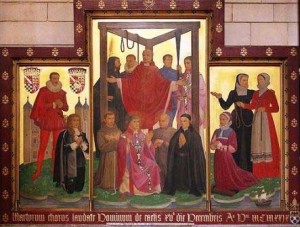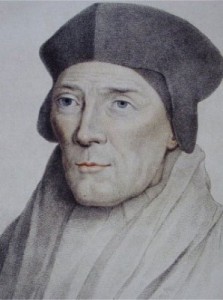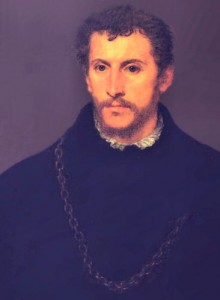St. John Fisher, 1460-1535
from the Catholic Information Network on St. John Fisher
John Fisher, born at Beverley, Yorkshire, was the son of a prosperous mercer who died in 1477. About 1482 the boy’s mother sent him to Cambridge University where he distinguished himself as a scholar. He was ordained in 1491 on the title of his Fellowship of Michaelhouse (now incorporated in Trinity College). After studying theology for ten years, he took his D.D. in 1501, and was later recognized as one of the leading theologians of Europe.
His university soon discovered his gifts as an administrator; he held in turn the offices of proctor, vice-chancellor and chancellor, and in 1514 he received the unique distinction of being elected chancellor for life. It was in the course of his university duties that, in 1494, he first met the Lady Margaret Beaufort, mother of Henry VII. He became her confessor and advised her on the charitable uses of her great wealth. It was at his suggestion that a preachership was endowed at Cambridge and Readerships in Divinity in both universities. He was largely responsible for her decision to refound and endow Godshouse as Christ’s College, and, after her death in 1509, he carried out her wishes in founding St. John’s College, to which he transferred lands given to him by the Lady Margaret.
He was made bishop of Rochester in 1504, and he ruled that poorest of sees for thirty years; he was a truly pastoral bishop, encouraging his priests by his manner of life and by his interest in their welfare. He was a noted and assiduous preacher, and he did all he could to provide well-instructed priests who could preach to the people.
It was due to his influence that Erasmus was brought to Cambridge as lecturer in Greek. He and Sir Thomas More became close friends of John Fisher, and there is a record of the three being together at Rochester in 1516. Sir Thomas More became High Steward of Cambridge University in 1525. He and John Fisher had been drawn closer together at this period by the call to combat the Lutheran heresy. The bishop wrote his Confutatio (1523) in Latin, a book for theologians by a theologian, which had a wide circulation on
the continent; the layman wrote his Dialogue Concerning Heresies (1528) in English for the common reader. It may be noted that in his sermons and writings against heretics, John Fisher never used the abusive language of contemporary controversy; he relied on reason and persuasion to bring back the prodigals.
The year 1527 was fateful to England, for it was then that Henry VIII took the first steps towards seeking the annulment of his marriage with Catherine of Aragon. She had married his elder brother Arthur in 1501; he died six months later. Catherine always maintained that the marriage had not been consummated. A papal dispensation allowed Henry VIII to marry his brother’s widow in 1509. The lack of a male heir turned his thoughts to the dissolution of his marriage; he argued that the papal dispensation had no validity. Cardinal Wosley was instructed to seek the opinion of John Fisher, whose prestige as a man of holy life and of great learning gave exceptional weight to his views. After studying the problem thoroughly he came to the conclusion that the papal dispensation was valid, and therefore that Henry and Catherine were man and wife in the eyes of the church. From that position he never moved in spite of the pressure brought to bear on him by king and cardinal. He was not content with passive opposition, but in the legatine court set up to try the issue, and from the pulpit, he defended the queen, although he knew that Henry regarded opposition to his will as a form of treason.
An attempt to implicate John Fisher in the fate of the Nun of Kent failed; she had prophesied against the king. A more certain weapon was provided by the Act of Succession of 1534. This declared the king’s marriage to Catherine void, and his subsequent marriage to Anne Boleyn to be lawful; the succession was settled on her children. All had to take an oath accepting the whole Act. When the oath was tendered to
John Fisher he refused to take it; so did Sir Thomas More. Both were prepared to accept the succession as determined by Parliament, but not that part of the Act which implied a denial of the pope’s authority, inasmuch as it declared the papal dispensation invalid.
On April 17th, 1534 Bishop John Fisher and Sir Thomas More were committed to the Tower. They were kept apart.
John Fisher was sixty-five years of age when he was imprisoned; he was suffering from a wasting sickness and was clearly nearing his end. Nothing shows the king’s vindictiveness more than his relentless persecution of this aged man stricken by a fatal illness. On May 20th, 1535, the pope created John Fisher Cardinal-priest of the title of St. Vitalis. This so infuriated the king that he hurried forward the proceedings against the new cardinal. (more…)
Tags: bishop, english reformation, John Fisher, martyr, martyrdom, martyrs of england, priests, protestant reformation
This entry was posted on Saturday, June 22nd, 2013 at 6:00 am
You can follow any responses to this entry through the RSS 2.0 feed.
Persecution of Catholics in England
[powerpress “faith-check-with-greg-youell”]
You’ve heard how the Pilgrims fled religious persecution in England, but have you ever heard how Catholics were persecuted there?
Recent scholarship such as Eamon Duffy’s book The Stripping of the Altars show that the vast majority of the English people did not freely choose to leave the Catholic Church, but were coerced into it. In fact, prior to King Henry VIII’s break with Rome, England was known throughout Europe as “Mary’s Dowry†because of its great piety. But under King Henry, Queen Elizabeth I, and others, failure to outwardly conform to the new state religion resulted in fines or imprisonment. Hiding a Catholic priest was considered a treasonable act punishable by death. Many suffered dearly, including famous martyrs like Sir Thomas More, or the 40 English martyrs that Pope John Paul II canonized.
Those openly professing Catholicism were barred from important positions in government and society well into the 1800s, and English law to this day prohibits a monarch from being Catholic.
Convincing evidence also shows that William Shakespeare was one such underground Catholic and that his plays included veiled appeals to the Queen for religious toleration.
So let us thank God that we can freely and openly practice our Faith, and honor all those who could not.
Tags: catholic, catholic podcast, catholic prayer, cathollc spirituality, england, martyrs of england
This entry was posted on Monday, January 2nd, 2012 at 7:16 am
You can follow any responses to this entry through the RSS 2.0 feed.
Trial and execution
Committed to the Tower of London, he was questioned in the presence of Queen Elizabeth, who asked him if he acknowledged her to be the true Queen of England. He replied she was, and she offered him wealth and dignities, but on condition of rejecting his Catholic faith, which he refused to accept. He was kept a long time in prison and reputedly racked twice. Despite the effect of a false rumour of retraction and a forged confession, his adversaries summoned him to four public conferences (September 1, 18, 23 and 27, 1581). Although still suffering from his ill treatment, and allowed neither time nor books for preparation, he reportedly conducted himself so easily and readily that he won the admiration of most of the audience. Tortured again on October 31, he was indicted at Westminster on a charge of having conspired, along with others, in Rome and Reims to raise a sedition in the realm and dethrone the Queen.
Edmund Campion, in a 1631 print.Campion was sentenced to death as a traitor. He answered: “In condemning us, you condemn all your own ancestors, all our ancient bishops and kings, all that was once the glory of England — the island of saints, and the most devoted child of the See of Peter.” He received the death sentence with the Te Deum laudamus. After spending his last days in prayer he was led with two companions, Ralph Sherwin and Alexander Briant, to Tyburn where the three sainted martyrs were hanged, drawn and quartered on December 1, 1581. He was 41 years of age.
Veneration and Feast Day
Edmund Campion was beatified by Pope Leo XIII on December 9, 1886. Blessed Edmund Campion was canonized nearly eighty-four years later in 1970 by Pope Paul VI as one of the Forty Martyrs of England and Wales with a common feast day of May 4. His feast day is celebrated on December 1, the day of his martyrdom.
The actual ropes used in his execution are now kept in glass display tubes at Stonyhurst College in Lancashire; each year they are placed on the altar of St Peter’s Church for Mass to celebrate Campion’s feast day—which is always a holiday for the school. – wiki
A Daily Prayer of St. Edmund
“I have made a free oblation of myself
to your Divine Majesty,
both of life and of death,
and I hope that
you will give me
grace and force to perform.
This is all I desire. Amen.”
-St. Edmund Campion
Tags: Blessed Edmund Campion, catholic, catholic podcast, catholic prayer, cathollc spirituality, death, edmund campion, england, feast day, Feast Day Edmund Campion, martyr, martyrdom, martyrs of england, queen elizabeth, Queen of England, saints
This entry was posted on Thursday, December 1st, 2011 at 12:02 am
You can follow any responses to this entry through the RSS 2.0 feed.


